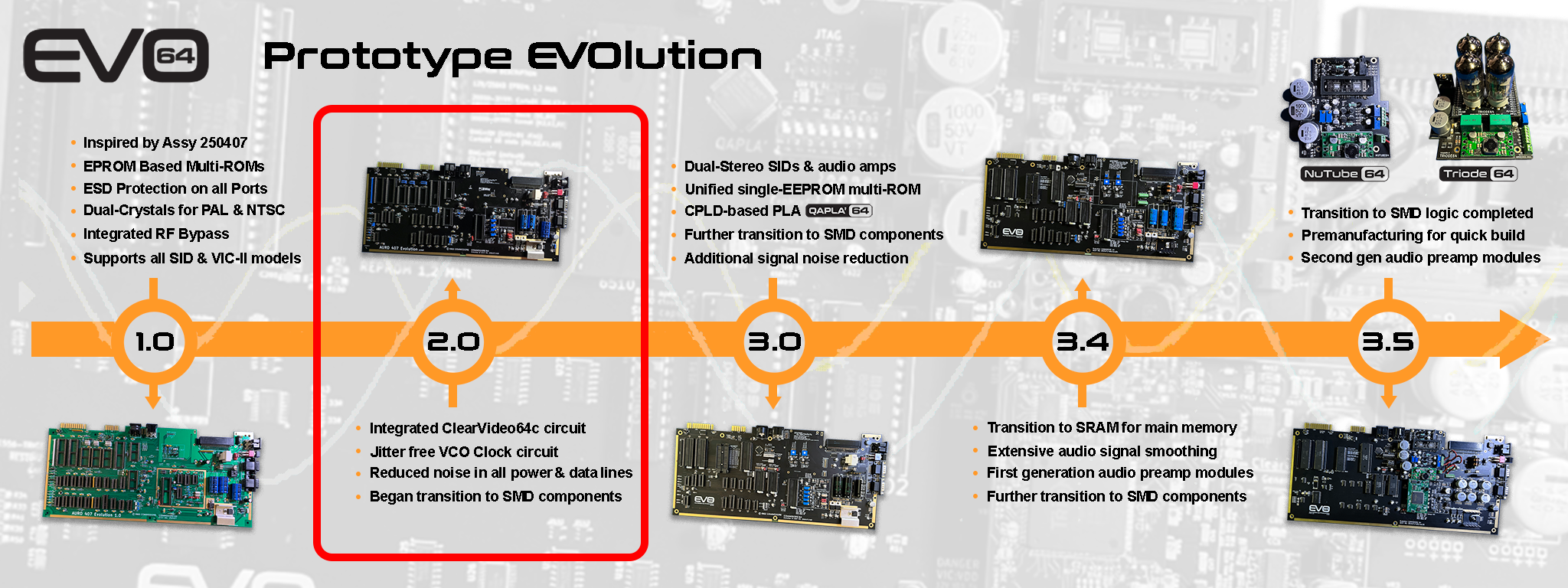Product Overview

By popular demand, the EVO64 Blue Pearl Edition is a reissue of an older prototype design, which is a bit closer to the original Assembly 250407 & 250466 designs used on earlier Breadbin systems.

Even at this earlier stage of EVO's development, there had already been a number of key modifications and improvements made over the original Commodore 64 main board, including:
- A "through-hole" component design that remains faithful to the aesthetic of the original Commodore Breadbin "longboards" (e.g. Assemblies 250407, 425, 466, etc.)
- A fully integrated ClearVideo64 circuit, inspired by the Jaystonian design, which eleiminates evidence of video artifacts, distortion and jailbars from your video signal
- Support for any VIC-II chip model, irrespective of whether you require PAL or NTSC video or prefer the earliest 12v VIC-II or the later 5v VIC-II, we have you covered. There's also full support for the Kawari VIC-II replacement
- Support for any SID chip model, whether you prefer the crunchy and glitchy sounds of the original 6581 SIDs @ 12v or the later 8580 SIDs @ 5v, with their cleaner and more consistent sounds, you're in business
- Multi-ROM support, via reprogrammable EPROMs. Each of the original C64 ROM chips have been replaced to provide support for up to 8x Kernals, 8x Basics and 16x Character sets
- The onboard DRAM (main memory) is modified to use two 41464 chips, similar to Assy 250466 & 469. These ICs are still available from component suppliers
- ESD Protection on all I/O ports, including Joysticks, Serial IEC and Video
- Support for forthcoming CROWBAR power breaker module
- Multiple DE-9 port footprints on the PCB for different size components or to tap for control over the analog paddles, which is a popular modification for music synthesizers
- Many PCB footprints support either Through-hole or SMD components (capacitors & resistors), which leaves the choice of component types up to the DIY builder
- An onboard tactile reset switch for convenience when testing and diagnosing, plus access to tap into the reset line for an external switch
IMPORTANT NOTES:
- This earlier board revision does NOT provide onboard support for dual-SID chips, and it does not support fully integrated cartridge ROM images
- If these types of enhanced features are important to you, please checkout the flagship EVO Production Release v1 board, which has all of these features and many more
- The EVO64 Blue Pearl is a 100% Do it Yourself (DIY) builder's project, intended for expert level electronics hobbyists and retro enthusiasts
- This build requires a variety of DIY skills and experiences, ranging from soldering basic through-hole parts, to much more complex SMD components and ICs with tighter pin packages, as well as EPROM programming.
- A complete Bill of Materials (BOM) has been prepared to help you source the required components and an Blue Pearl Interactive BOM has been created to help you identify the correct component placement
- Builder support is available through the EVO64 DIY Builder's Discord Channel
FREQUENTLY ASKED QUESTIONS:
1. Is the Blue Pearl an upgrade to the previous EVO Release v1?
- Put simply, NO it is not. Blue Pearl is a reissue of an older EVO prototype model, which has fewer features than the flagship production EVO Release 1 model
2. Why did the EVO team make the Blue Pearl board?
- Some hobbyists like the aesethetic of the "through-hole" components used on the original Commodore mainboards and they requested that we release this specific prototype, which has a great featureset and hadn't transistioned quite so many components to SMD yet
3. Does the Blue Pearl support dual-SID chips?
- This board revision does not have integrated onboard support for dual-SID chips, but you're free to add any of the third party solutions out there that enable support for multiple-SIDs, such as the MixSID or SIDFX boards, ARM2SID, SIDKick, FPGASID and others
4. Can I add a NuTube64 or Triode64 to the BluePearl?
- The short answer is yes, but you will need to route some wires for the power and the audio signal to make them work
- You also need to ensure that you're using a powerful enough power supply unit (PSU), bridge rectifier and the correct fuse, because the preamps do require additional power for the tubes
5. Where can I find a full Bill of Materials (BOM) to make the Blue Pearl?
- A full component BOM has been published, which contains detailed descriptions of each component type and Mouser part numbers.
- Experienced builders are obviously free to use any components they prefer, as long as they match the correct specifications
6. Why is the Blue Pearl considered to be an Expert level DIY project, whereas the Production EVO is said to be more of an Intermediate level build?
- The Blue Pearl board is shipped as a completely blank PCB, whereas the production EVO boards are mostly preassembled and fully-tested as part of the manufacturing process
- The EVO team are providing a comprehensive component BOM for the Blue Pearl, but you'll notice that there are many more components to hand-solder versus the production EVO boards, so this build will definitely take longer to complete
- Most of the Blue Pearl DIY build is straight forward, requiring only basic through-hole soldering, but there are several smaller SMD components that are a bit more difficut for the less experienced builders (e.g., ESD chips, resistor network ICs, inverters and schmidtt triggers)
- Many of the component footprints on the Blue Pearl were designed to support either a standard through-hole part or an SMD equivalent (resistors and capacitors). So, if you enjoy SMD soldering, you're free to have at it
- To enhance the build experience with Blue Pearl, we've published an "Blue Pearl Interactive BOM", which makes it super easy to identify component placement locations and keep track of your build progress













